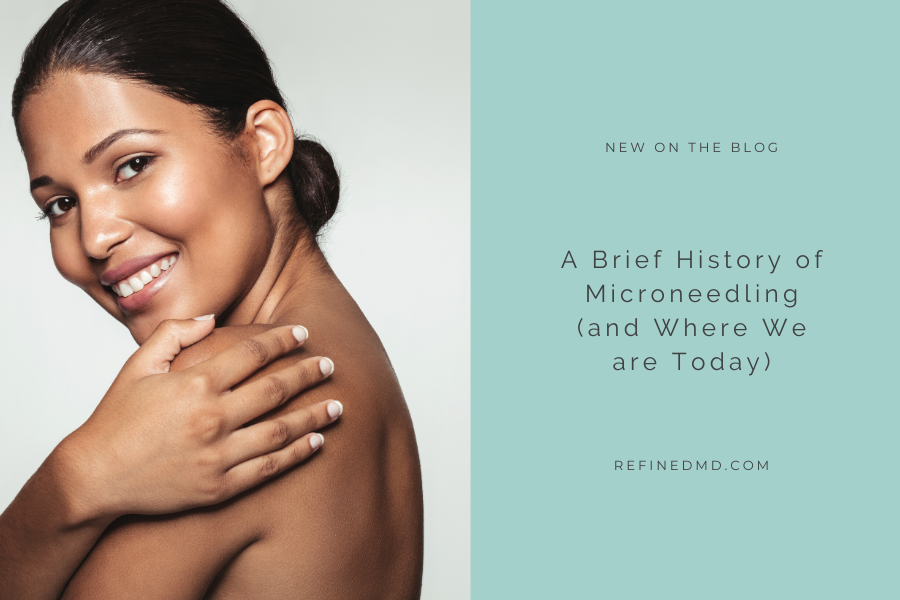
01 Oct A Brief History of Microneedling (and Where We are Today)
Microneedling is both one of the oldest beauty techniques and one of the most popular procedures at RefinedMD. It has its roots in ancient China with acupuncture, specifically in the book The Yellow Emperor’s Classic of Internal Medicine (100 B.C.E.). However, the goal of “microneedling” at that time wasn’t necessarily collagen induction therapy, at least not in those terms. Acupuncture was a means of opening conduits so that the Qi (life force) could flow more easily. Today, acupuncture is still used as a tool for promoting self-healing—which is what microneedling does! It’s possible that the collagen induction stimulated by ancient acupuncture revealed itself in improved skin which, of course, is a sign of good health.
That’s the origin story of microneedling, but microneedling as we know it today was first used in 1905 by a German dermatologist. Ernst Kromayer used a variety of dental burs (a tiny drill) with a flexible cord to treat hyperpigmentation, scars, and birthmarks. It quickly came to be known as a useful tool in helping war veterans with scarring. We have, of course, come a long way since the days of Kromayer literally drilling patients, but the concept is the same. When you create a controlled trauma, the result is a surge of collagen synthesis at that site.
Modern Day Microneedling
Microneedling as we would recognize it today started in 1995 with Dr. Desmond Fernandes. This Philadelphia-based dermatologist used hypodermic needle injuries to help with scars and wrinkles. Once he realized how well it worked, he developed his own small “stamp” of needles, and that’s similar to what we still use today. It’s much quicker and more efficient to glide a handheld device with hundreds or thousands of needles across the skin rather than prick the area with a single needle hundreds of times (as Fernandes and everyone before him had done).
Not long after his invention, it was discovered that microneedling was helpful with a lot more than wrinkles and scars. It can also tighten the skin, smooth it, and—as was re-realized in the 1990s—was an excellent tool for hyperpigmentation. It can even help to treat stubborn hyperpigmentation like melasma and the difficult to treat stretch marks. However, not all microneedlers or tools are created equally. We only offer the most skilled providers and the latest technology.
Should You Schedule Your Session?
Now that summer is behind us, right now is the perfect time to kickstart a microneedling regimen. You can get a head start on undoing summer sun damage and set a precedence for glowing skin by those holiday parties. Traditional microneedling is a regimen, and since results are slow but steady it will take a few weeks to keep and sustain optimal results—in other words, just in time for those NYE events.
Microneedling has also long been paired with topical treatments. Since microneedling creates temporary “channels” in the skin, it’s prime time to apply medical-grade cosmetics. That’s why we often recommend following up microneedling (including Morpheus8) with a HydraFacial. HydraFacial exfoliates the skin, cleans out the pores, and infuses the skin with hand-picked medical-grade topicals. You can try out a new topical without committing to an entire bottle and are guaranteed to leave your Morpheus8-HydraFacial appointment with glowing, supple skin.
The results of microneedling are typically deemed cumulative, with many people getting monthly sessions. However, since Morpheus8 features RF energy and is much more powerful, it’s common to only need a treatment once or twice per year. This is a bonus for those with busy schedules or who simply want to be able to enjoy the benefits of their treatment for longer. To find out more, schedule a complimentary consultation today. Call RefinedMD during business hours or, for the fastest response, complete the online contact form now.
